tr:Evangelion'daki Savaş Gemileri: Difference between revisions
Mbselvitopu (talk | contribs) |
Mbselvitopu (talk | contribs) |
||
| Line 157: | Line 157: | ||
==IJN Soryu(蒼龍 )== | ==IJN Soryu(蒼龍 )== | ||
[[Image:Carrier Soryu.jpg|250px|left|thumb|IJN Soryu]] | [[Image:Carrier Soryu.jpg|250px|left|thumb|IJN Soryu]] | ||
( | ([[tr:Asuka|Asuka]] ve [[tr:Kyoko Zeppelin Soryu|Kyoko]]'nun adaşı) | ||
Soryu | Soryu, Japon İmparatorluk Donanması'nın amaca yönelik ilk ağır uçak gemisiydi; sadece bir uçak gemisi olarak inşa edildi ve daha eski gemiler Akagi (yarı inşa edilmiş bir savaş gemisinden dönüştürülmüş) ve Kaga (yarı inşa edilmiş bir zırhlıdan dönüştürülmüş) ile öğrenilen deneyimlere dayanarak inşa edildi. Tanıtıldığı sırada, 34.5 knot hızıyla dünyanın en hızlı taşıyıcısıydı. Kaga'nın maksimum hızına tam gücünün yalnızca yüzde kırkında yetişebiliyordu ve ikiz dümenleri ona olağanüstü manevra kabiliyeti kazandırdı. Soryu'yu, yaklaşık 2000 ton daha ağır olan ve farklı bir uçuş güvertesi ve ada konfigürasyonuna sahip olan modifiye edilmiş kardeş gemisi Hiryu izledi. | ||
Soryu | Soryu, Pearl Harbor saldırısına katılan altı uçak gemisinden biriydi ve takip eden aylarda çok sayıda başka pasifik kampanyasında görev yaptı. 4 Haziran 1942'de Soryu, USS Yorktown'dan pike bombardıman uçakları tarafından saldırıya uğradı ve üç bomba isabeti aldı. İkisi üst hangar güvertesini deldi ve üçüncüsü, patlama, su şebekelerini kırma, havacılık gaz hatlarını parçalama, kazan buhar hatlarını delme ve hangar güvertelerinde depolanan silahlı ve yakıtlı uçaklar arasında zincirleme gibi bir reaksiyon başlatmadan önce alt hangar güvertesine indi. Güç kaybı, Soryu'nun gecenin ilerleyen saatlerinde muhrip torpidoları tarafından batırılmadan önce aceleyle terk edilmesine yol açtı. Soryu'nun nispeten hafif yapısı, geminin büyük ölçüde yapısal hasar görmesine neden oldu ve daha az güverte, yangın ve patlamalara yakınlığı nedeniyle makine dairesindeki ve diğer iç mekanlardaki mürettebat için daha büyük tehlike oluşturuyordu. Her iki hangar güvertesinde çıkan yangınlar nedeniyle Midway'de kaybedilen dört gemi arasında mürettebatın en yüksek oranı olan 1103 mürettebatından 711'ini kaybetti. | ||
Tüm amaca yönelik Japon gemileri, efsanevi veya kutsal uçan yaratıkların adını almıştır. Bu durumda, Soryu kelimenin tam anlamıyla yeşil (veya mavi) ejderha anlamına gelir. Asuka'nın soyadı, taşıyıcının adının bir homofonu olmasına rağmen, bunun yerine 惣流 olarak yazıldığından, iki Kanji ayrı ayrı "her şey/hepsi" ve "akış/akı/akıntı/aktarım" anlamına gelir. | |||
{{-}} | {{-}} | ||
Revision as of 10:12, 16 August 2021
Neon Genesis Evangelion franchise'ı, savaş gemilerine çok sayıda referansın yanı sıra, gerçek dünya savaş gemilerini belirgin bir şekilde içerir. Bu sayfa, dizideki karakterlerin adını aldığı İkinci Dünya Savaşı gemilerinin listesini, özellikle TV dizisinin 8. bölümünde ve Evangelion 3.0'da ekranda görülen savaş gemileriyle birleştiriyor. Amaç, franchise yaratıcılarının dahil ettiği veya şu veya bu şekilde atıfta bulunduğu tüm gemilerin mümkün olduğu kadar tam bir listesini sağlamaktır, ancak franchise'daki çok sayıda savaş gemisinin muhtemelen birkaçını ıska geçtiği konusunda önceden uyarılmalıdır.
Savaş Gemisi Türleri
Evangelion'un "tarihi savaş gemileri" İkinci Dünya Savaşı dönemine aittir. O dönemden bazı gemi türleri tamamen ortadan kalktı; örneğin, savaş gemileri 1950'lerden beri çoğunlukla müze parçalarına indirgendi (birkaç Amerikan gemisi dışında) ve "ağır" ve "hafif" kruvazörler arasındaki ayrım çoktan ortadan kalktı ve neredeyse tüm kruvazör türleri düz "kruvazör" olarak adlandırıldı. Uçak gemileri çoğunlukla daha büyük ve daha iyidir (Amerikan süper gemileri "devasa"dır, ancak tüm gemiler o kadar büyük değildir) ve muhripler eski hafif kruvazörlerin boyutuna ulaştı ve fırkateynler 2. Dünya Savaşı muhriplerinin boyut kategorisini aldı.
Uçak Gemileri
Bir uçak gemisi, kelimenin tam anlamıyla kilometrelerce uzaktan tespit edilebilir. Modern bir Nimitz sınıfı süper gemi, şimdiye kadar yapılmış en büyük, en ağır savaş gemisidir, bin fitten fazla uzunluğa ve 100.000 tondan fazla ağırlığa sahiptir. Tüm uçak gemileri, uçakların kalkış ve iniş yapmasına izin vermek için düz ve geniş bir güverteye sahiptir. Modern uçak gemileri, üzerinde ve içinde çok sayıda uçakla bulunur ve her zaman birkaç eskort eşlik eder. Donanma söz konusu olduğunda, "Üstün Ateş Gücü ile Barış"ın ("Peace through Superior Firepower") ilk ve son sözü uçak gemisidir. İkinci Dünya Savaşı gemileri, modern muadillerinin çoğundan daha küçüktü, ancak modern gemilerden daha fazla, hatta çok daha fazla fazla uçak taşıyordu (ortalama pervaneli uçak, modern bir jetle karşılaştırıldığında olumlu bir şekilde küçüktü). Her iki durumda da, savaş sırasında uçak gemileri, bugün uçak gemilerinin yaptığı rolün hemen hemen aynısını gerçekleştiriyordu: gemilere, uçaklara ve kara hedeflerine karşı ezici bir güç sağlamak.
Savaş Gemileri
Büyük silahlı bir savaş gemisi, bir samuray kılıcına çok benzerdir: Görülmesi muhteşem, ölümcül, güçlü ve çok korkulan, ancak modern savaşta nihayetinde oldukça işe yaramaz. "Savaş gemisi diplomasisi" günleri, Japonya ve Amerika'nın uçak gemisini üstün hüküm sürdüğü noktaya kadar geliştirdiği İkinci Dünya Savaşı'nda sona erdi. 45.000 yarda mermi fırlatabilen bir savaş gemisi, uçaklarını 450 mil menzile getirebilecek bir uçak gemisine karşı çaresizdi. Şimdiye kadar yapılmış en güçlü savaş gemileri olan Yamato ve Musashi bile hava saldırısına uğradı ve bu devasa silahların düşman savaş gemilerine saldırmaktan çok kıyı bombardımanı için kullanıldığı ortaya çıktı. Sonunda, savaş gemileri çıkarma birliklerini destekledi ve uçak gemilerine ekstra uçaksavar koruması sağladı.
"Savaş gemisi" (battleship) kelimesi bazı insanlar tarafından "savaş gemisi" (warship) yerine kullanılsa da teknik olarak yanlıştır (ve can sıkıcı): Bir zırhlı aslında, döner kulelerde devasa topları ve düşman zırhlılarından gelen mermileri emmek için bol miktarda zırhı olan, "belirli" bir savaş gemisi (warship) türüdür. Terim, "Savaş Gemisi Hattı" (Line of Battle Ship) haline gelen "Savaş Hattı Gemisi"nden (Ship of the Line of Battle) ve 19. yüzyılın sonlarında sadece "Savaş Gemisi"nden (Battleship) ortaya çıktı. 20. yüzyılın şafağında, bir savaş gemisine sahip olan herhangi bir ülke, (bugünkü nükleer silahlara sahip ülkeler gibi) ağırlığını ortaya koyabilecek prestijli, seçkin bir ulus grubuna aitti; mayınlara, denizaltılara ve uçaklara karşı savunmasız oldukları ortaya çıktı. Amerika Birleşik Devletleri'nde, en ünlülerinden biri, batık USS Arizona zırhlısının arkasında Pearl Harbor'da demirleyen USS Missouri olan birkaç korunmuş savaş gemisi var.
Ağır Kruvazörler ve Hafif Kruvazörler
Ağır kruvazörler, büyük topları ve zırh kaplamalarıyla normal zırhlılarla kolayca karıştırılabilir, ancak hem silah hem de zırh açısından her zaman daha küçük, daha ince ve çok daha hafiftirler. Bu gemiler, daha büyük gemiler için eskort olarak, düşman ticari gemilerini yok etmeyi amaçlayan "ticaret akıncıları" olarak başladı. Birçoğu güçlü motorlarla ve onlara hızlı hareket eden uçak gemilerine ayak uydurabilmeleri için hız veren uzun, dar bir gövdeyle inşa edildi ve savaş gemileri gibi karadaki birliklere hayati ateş desteği sağladılar.
Hafif kruvazörler ağır kruvazörlere daha az benziyordu, çok daha küçük silahlarla ve daha zayıf zırhlarla inşa edildi ve çoğunlukla daha küçük yüzey gemileriyle savaşmak veya muhrip gruplarını saldırıya yönlendirmek için tasarlandı.
Modern kruvazörler ve modern muhripler rollerinde örtüşür, ancak bazı Soğuk Savaş dönemi kruvazörleri nükleer güçle ayırt edilirler ve bu da onlara pratik olarak sınırsız menzil sağlar. Kirov sınıfı füze kruvazörü, yeni bir gemi türü değil, özellikle büyük modern bir kruvazördür.
Muhripler ve Fırkateynler
Muhripler (destroyer), savaş gemilerinin yanlarında delik açmakla tehdit eden torpido taşıyan tekneleri yok etmeye başladılar, bu yüzden isimleri böyledir. Bununla birlikte, muhripler kısa sürede boyut, hız ve yıkıcı güç olarak büyüdü ve zırhlıları, yan gövdelerinde delikler açma tehlikesiyle karşı karşıya bıraktı. İkinci Dünya Savaşı'ndan kalma Japon muhripleri hızlı, güçlüydü ve özellikle geceleri uyandıklarında ölümcül olan torpido bataryalarıyla donanmışlardı. Modern muhripler, torpidoları gemi karşıtı rollerinde kullanmazlar, bunun yerine denizaltılardan kurtulmak için kullanırlar.
Fırkateynler, şu anda tanımlandığı şekliyle, muhriplerden tipik olarak daha küçük ve daha kısa menzilli olan ve tam boyutlu bir muhripin gereksiz olduğu görevleri üstlenmeleri amaçlanan gemilerdir.
Modern muhripler ve fırkateynler, düşman uçaklarını, denizaltılarını ve gemilerini yok etmek için füzeler ve torpidolar kullanır. Amerikan, Çin, Hint, Rus ve Japon donanmaları tarafından kullanılan türden büyük günümüz muhripleri, büyüklük ve yetenek bakımından kruvazörlerle büyük ölçüde örtüşmektedir. Fırkateynlerin büyüklük ve ateş gücü olarak muhripleri yakalamasıyla, modern gemiler arasındaki "muhribat", "kruvazör" ve "firkateyn" arasındaki ayrım bulanıklaşıyor.
Denizaltılar
"Denizaltı botları" (submarine boats) veya "denizaltı botları" (undersea boats) (Almanca'da Unterseeboot ismi tam olarak bu demektir) olarak yola çıkan denizaltılar, 19. yüzyılda çeşitli biçimlerde denenmişti ancak ilk gerçek modern askeri denizaltılar, çoğu Almanya'da inşa edilen 20. yüzyılın başında ortaya çıktı. Her iki Dünya Savaşı sırasında da denizaltıların ticari gemileri batırmada son derece etkili olduğu ortaya çıktı; İkinci Dünya Savaşı'nda Japonya'yı gıda ve temel hammaddelerden mahrum bıraktı ve her iki savaşta da İngiltere'yi neredeyse açlıktan öldürdü. Modern nükleer denizaltılar çok daha az savunmasız olsa da, İkinci Dünya Savaşı sırasında denizaltı karşıtı savaştaki ilerlemeler gelgiti denizaltıların aleyhine çevirdi. Nükleer enerjili balistik füze denizaltıları, şimdiye kadar denize açılan en güçlü ve tehlikeli deniz gemileridir.
Karakter İsimleri (İkinci Dünya Savaşı Dönemi Japon İmparatorluk Donanması Savaş Gemileri)
IJN Akagi(赤城)
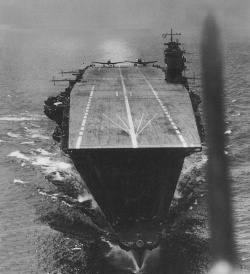
(Ritsuko ve Naoko Akagi'nin adaşı)
Akagi, tüm Japon savaş gemilerinin en ünlülerinden biriydi ve kesinlikle en ünlü Japon uçak gemisiydi. Akagi, 1920'de Amagi sınıfı bir muharebe kruvazörü olarak atıldı ve 1922 Washington Donanma Antlaşması sayesinde uçak gemisine dönüştürüldü: 1922 Washington Donanma Antlaşması; Amerika, Birleşik Krallık, Fransa, İtalya ve Japonya arasında, tüm uluslara savaş gemisi tasarımı ve üretimine sınırlamalar getiren ve inşa edebileceği toplam gemi ağırlığını kısıtlama konusunda Japonya için oldukça hayal kırıklığı yaratan bir anlaşmadır. Akagi'nin "Kızıl Kale" anlamına gelen adı, Japonya'nın Gunma Eyaletindeki Akagi Dağı'ndan (赤城山,Akagi-san) aynı adı taşıyan bir dağdan gelir (Savaş kruvazörü adını korurken, amaca yönelik uçak gemilerine gerçek veya efsanevi uçan yaratıkların adı verildi). Akagi, hangarları ve uçuş güvertesi üzerine inşa edilmiş orijinal muharebe kruvazörü tasarımının gövdesine ve motorlarına sahip olduğundan, hızlı ve güçlüydü, ilk uçak gemilerinin en iyilerinden biriydi.
Akagi, 7 Aralık 1941'de Pearl Harbor'a düzenlenen ve Oahu'da iki dalga uçak fırlatan Koramiral Chuichi Nagumo'nun amiral gemisi olarak hizmet ettiğinde tarihteki yerini mühürledi. Sonraki altı ay boyunca sürekli olarak aktif oldu ve Yeni Gine'deki Bismarck adalarındaki Rabaul limanının işgalini desteklemek gibi Pasifik'teki diğer kampanyalarda görev yaptı. Uçağı, dünyanın ilk amaca yönelik uçak gemisi İngiliz uçak gemisi HMS Hermes de dahil olmak üzere birçok gemiyi batırdı.
Akagi'nin son savaşı Midway Muharebesiydi ve burada kaybedilen dört Japon gemisinden biri olacaktı ve bu yenilgi, Pasifik'teki Japon İmparatorluğu'nun sonunun başlangıcını tetikleyecekti. 4 Haziran 1942'de Akagi, Uçuş Teğmen Richard Best'in USS Enterprise uçak gemisinden üç pike bombardıman uçağı bölümü tarafından saldırıya uğradı. Akagi, en sonunda tamamen kontrolden çıkan bir yangını başlatan ileri asansöre -Best'in kendisinden- bir darbe aldı. Akagi'nin kıç tarafı ramak kala dümeni tıkayan şok hasarına neden oldu. Yangın ve patlayan mühimmat nedeniyle ciddi şekilde hasar gördü, ancak hâlâ yüzüyordu, ertesi gün dört muhripten gelen torpidolar tarafından suya düştü. Akagi, kaybedilen dört uçak gemisinin en şanslısıydı ve tüm mürettebat arasında en az ölüme maruz kaldı.
Savaş gemilerinde sıklıkla olduğu gibi, Akagi Japon Donanması'nın bu ismi taşıyan ilk gemisi değildi. İlk Akagi, on dokuzuncu yüzyılın sonlarında Maya sınıfı bir savaş gemisiydi. (Evangelion terimleriyle oldukça ironik, çünkü Maya Ibuki, Ritsuko Akagi'ye karşılıksız bir aşıktır). Adını taşıyıcıdan almasına rağmen, Ritsuko'nun soyadı, "Kızıl ağaç" anlamına gelen 赤木 olarak farklı karakterlerle yazılmaktadır ("ağaç" anlamına gelen ki 木 karakteridir).
IJN Aoba(青葉)
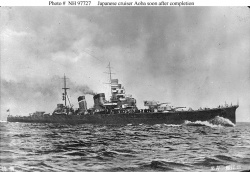
(Shigeru Aoba'nın adaşı) Aoba, iki gemili Aoba sınıfı ağır kruvazör sınıfında lider gemiydi, İkinci Dünya Savaşı patlak verdiğinde biraz daha eski ve daha zayıftı, ancak bu büyüklükteki bir gemi için oldukça sağlamdı. Altı adet sekiz inçlik topunu, ikisi öne, biri geminin arkasına bakan üç ikiz kuleye monte etti ve bu, ona çoğu zamanının kruvazörden daha az ateş gücü sağladı, ancak kısmen torpido silahını telafi etti.
Altıncı Japon kruvazör bölümünün amiral gemisi olarak, Aoba, Pearl Harbor'a yapılan saldırı sırasında, Caroline Adaları'ndaki Truk'tan yola çıkarak ve Solomon Adaları'na inen Japon birliklerine koruma sağlayarak Guam'ı işgal etti.
Mercan Denizi Savaşı'nı gördükten sonra, Ağustos 1942'de Japon savaş gemilerinin Amerikan gemilerini bir gece silahı ve torpido savaşına soktuğu Savo Adası Savaşı'na katıldı. Japon Donanması, önemli ölçüde daha büyük olan ABD Donanması'na karşı koymak için torpidolara ve gece savaş tekniklerine büyük yatırım yaptı ve bu yatırımı iyi bir sonuç verdi. Üç Amerikan savaş gemisi ve bir Avustralya savaş gemisi battı ve üçü daha hasar gördü. Savo Adası Savaşı, Birleşik Devletler Donanması'nın düz bir savaşta karşılaştığı en küçük düşürücü yenilgilerden biriydi ve Aoba da bunun bir parçasıydı.
Aynı yılın Ekim ayında Cape Esperance Muharebesi'nde Aoba, kendisine atılan kırk tane 6 inçlik ve 8 inçlik mermilerden ciddi şekilde hasar gördü, ancak sonunda onarım için Japonya'ya döndü. Savaşın geri kalanında çoğunlukla eskort görevlerinde bulundu, uçak ve denizaltı saldırıları tarafından tekrar tekrar hasar gördü ve sonunda hasarın onarılamaz olarak kabul edilmesinden sonra yedek gemi olarak Japon limanı Kure'ye getirildi.
Aoba, bir başka bombalamadan sonra uçaksavar "Hulk'a" dönüştürüldü ve Temmuz 1945'te yapılan son bombalı saldırı, bu dayanıklı hayatta kalanları sonsuza dek etkisiz hale getirdi. Enkazı savaşın bitiminden sonra hurdaya çıkarıldı.
IJN Ayanami(綾波)
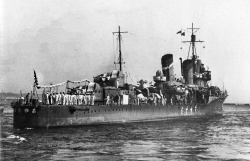
(Rei Ayanami'nin adaşı)
Ayanami, dünyanın ilk modern muhripinin geliştirilmiş bir versiyonu olan Tip-II Fubuki sınıfı muhriplerin ilkiydi. Ayanami, özel modeli için bir adaşı olarak hizmet etti (Kız kardeşi "Shikinami" tamamlanıp hizmete giren ilk gemi olmasına rağmen, Ayanami tam altı ay önce hazırlanmıştı).
Eski Fubuki sınıfı, 1920'lerde var olan diğer tüm muhrip türlerinden daha büyük, daha hızlı ve daha güçlüydü, tamamen kapalı köprüler ve silahlarla dolu (mürettebatları hava koşullarından koruyan ve çok daha üstün çalışma koşulları sağlayan) bir gemiydi. Ayanami alt sınıfı, önceki gemilerden sadece 40 derece yerine 75 dereceye yükselebilen bir top kulesi ile ayrıldı ve bu da onu, uçaksavar kullanımına konabilecek bir ana topa sahip olan dünyadaki ilk muhrip yaptı (silah pratikte uçağa nişan almak için çok yavaştı). Fubuki sınıfının diğer gemileri gibi, Ayanami de ağır silahlarla donatılmıştı ve ölümcül 610mm Tip 93 "Uzun Mızrak" torpido için üç adet üçlü torpido tüpü fırlatıcısı vardı; bu silah, yabancı emsallerinden daha yüksek hıza, daha uzun menzile ve daha ağır darbeye sahip bir silahtı. Ayanami'nin torpidoları, yirmi kilometrede herhangi bir gemide büyük bir delik açabilirken, ABD muhripleri kendi torpidolarını kullanmak için mesafenin yarısına yaklaşmak zorunda kalacaktı.
Aralık 1941'de Ayanami, kardeş gemileri Uranami ve Yugiri ile birlikte Hollanda denizaltısı O-20'yi batırdı ve Mart 1942'de Ayanami, Bengal Körfezi'ndeki Andaman Adaları'nın işgali için yakın koruma sağladı. Buna ek olarak, Midway Savaşı sırasında Amiral Yamamoto'nun ana gövdesi için bir eskort olarak görev yaptı ve kardeş gemileri Isonami, Shikinami ve Uranami ile birlikte Destroyer Division 19'u oluşturdu.
Ayanami'nin son eylemi, 14-15 Kasım 1942 gecesi, Uranami ve Nagara ile birlikte, USS Washington zırhlısı tarafından fark edilmeden ve bombalanmadan önce birden fazla ABD muhripine ciddi hasar veren İkinci Guadalcanal Savaşı oldu. Kritik hasara uğrayan ve mürettebatından kırk kişi ölen geminin mürettebatının geri kalanı ya tekneyle Guadalcanal'a ya da Uranami'ye tahliye edildi. Uranami'den gelen tek bir torpido tarafından suya düştü. Enkazı, Temmuz 1992'nin sonlarında deniz arkeoloğu Robert Ballard ("Titanic" ve "Bismarck" ile ünlü olmuştur) tarafından Ironbottom Sound'un dibinde keşfedildi.
IJN Fuyutsuki(冬月)
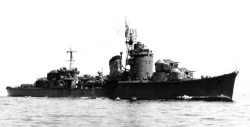
(Kozo Fuyutsuki'nin adaşı)
Fuyutsuki, Japon Donanması'nın Akizuki sınıfı bir muhripti, adı tam anlamıyla "Kış Ayı" anlamına geliyordu. Ana gemilere uçaksavar destek ateşi sağlayabilen oldukça gelişmiş ve güçlü bir gemi için, savaş zamanı sicili oldukça sıradandır. Fuyutsuki, 12 Ekim 1944'te USS “Trepang” denizaltısından pruvada bir torpido darbesi almasına ve gelecek yılın Ocak ayına kadar yeniden hizmete girmesine rağmen, çoğunlukla nakliye gemilerine veya diğer düşük öncelikli gemilere eskortluk yaptı. Fuyutsuki'nin şöhretinde kayda geçen bir olay var: O, büyük geminin Ten-Go Operasyonu'ndaki intihar görevi sırasında Yamato'nun güçlü zırhlılarından biriydi ve Yamato Amerikan uçakları tarafından batırıldıktan sonra hayatta kalanları kurtardı. 20 Ağustos 1945'te Fuyutsuki bir mayın tarafından hasar gördü ve onarılmadan ve silahsız olarak teslim oldu. Üç ay sonra Donanma Listesinden çıkarıldı ve hurdaya ayrılmadan önce bir dalgakıran görevi gördü.
Evangelion'da bulunan gemilere ayrılmış bir sayfada özel olarak bahsedilen Fuyutsuki'nin Yamato'nun mürettebatını kurtarmadaki rolü, Evangelion yaratıcısı Hideaki Anno tarafından sevilen bir seride popüler kültürde tekrarlandı: Uzay Savaş Gemisi Yamato (Space Battleship Yamato) serisinin Final Yamato filminde aynı adı taşıyan bir uzay muhripi görünür ve gerçek muhripin en ünlü eylemine atıfta bulunarak aynı isimdeki uzay savaş gemisinin mürettebatını tahliye eder.
IJN Hyuga(日向)
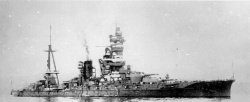
(Makoto Hyuga'nın adaşı)
Hyuga, önceki Fuso sınıfı zırhlının büyük ölçüde yeniden tasarlanmış bir versiyonu olan Ise sınıfı bir zırhlı olarak inşa edildi. Bu zırhlı tiplerinin her ikisi de, uzunluklarının çoğunda ana top kuleleri olan tuhaf görünümlü gemilerdi. Zırhları, gemi uzunluğunun bu kadar önemli bir bölümüne dağılmış olmaları nedeniyle inceltilmek zorundaydı ve bu da onları bir şekilde koruma noktasında kötüleştiriyordu. 1918'de tamamlanan Hyuga, 1926'dan 1928'e ve yine 1934'ten 1936'ya kadar kapsamlı bir şekilde geliştirilip kullanıldı.
Dört uçak gemisinin kaybedildiği feci Midway Savaşı'ndan sonra IJN, Yamato ve Musashi dışındaki tüm zırhlıları uçak gemisine dönüştürmeyi düşündü; sonunda, en eski ve en az kullanışlı zırhlıları hibrit zırhlılara/taşıyıcılara dönüştürme, uçakların zırhlı gemilerinden havalanması ve konvansiyonel gemilere veya kara üslerine inmesi planına karar verildi. Sonunda, uçağın olmaması ve düzenlemenin tamamen pratik olmaması, Hyuga ve Ise'yi bu rolde işe yaramaz hale getirdi. Sonuç olarak, savaştaki rolleri neredeyse sıfırdı, ne tam savaş gemileri ne de uygun taşıyıcılar oldukları için belirsizliğe düştüler.
Hyuga, Temmuz 1945'te Kure yakınlarında Amerikan uçaklarının saldırısı sırasında sığ sularda karaya oturdu. Savaşın bitiminden sonra, kaldırıldı ve hurdaya çıkarıldı.
Hyuga'nın adı, Kyushu'daki Hyuga adlı eyaletten geldi.
IJN Ibuki(伊吹)
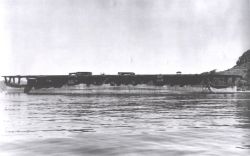
(Maya Ibuki'nin başka bir adaşı)
Ibuki, asla tamamlanmayan bir gemiydi. Güçlü Mogami sınıfı ağır kruvazörün geliştirilmiş bir versiyonu olması gerekiyordu, mümkün olduğunca iyi bir savaş gemisi tasarımı yapmak için 1922 Washington Donanma Antlaşması'nın ağırlık sınırlamaları kaldırıldı.
Midway Savaşı'ndan sonra, kendisi tam bir uçak gemisine dönüştürülmeden önce uçak gemisi üretimine yol açmak için inşaatı yavaşladı. Ancak, bombalama ve akut malzeme kıtlığı, Mart 1945'e kadar inşaatı imkansız hale getirdi. Eylül ayında işgalci güçlere teslim olduğunda yüzde 80 tamamlanmıştı ve iki yıl sonra hurdaya çıkarıldı.
IJN Katsuragi(葛城)
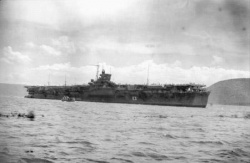
(Misato Katsuragi'nin adaşı)
Katsuragi, IJN'nin Unryu sınıfı bir uçak gemisiydi. Unryu sınıfı, Hiryu'nun konfigürasyonunu aldı (Hiryu'nun kendisi, Soryu'nun biraz daha büyük bir modifikasyonuydu) ve ada yapısını tutarlı bir şekilde geminin sancak/sağ tarafına yerleştirdi (Akagi ve Hiryu'nun adaları limanda/soldaydı). Ayrıca, Hiryu ve Soryu'nun çok güçlü motorlarını, üretimi hızlandırmak ve maliyetleri düşürmek için kruvazör veya muhrip tasarımlarından ödünç alınan daha zayıf motorlarla değiştirdiler, böylece onları yavaşlattılar. Savaşın sonlarında biten Katsuragi, herhangi bir ciddi eylemde bulunmadı ve çoğunlukla "Okha" kamikaze roket uçakları için bir feribot görevi gördü. Savaştan sağ çıktı, 1947'de hurdaya ayrılana kadar geri dönen birlikleri feribotla indirdi.
Unryu'nun aksine ama Amagi gibi, Katsuragi, efsanevi bir uçan yaratık yerine, ağır kruvazör adlandırma kurallarına uygun olarak bir dağın adını almıştır. Katsuragi, adını şu anda Japonya'da Nara Eyaleti olan Yamato Katsuragi Dağı olarak da adlandırılan Katsuragi Dağı'ndan almıştır. İlk karakter, 葛, "Kudzu" anlamına gelir ve daha yaygın olarak "asma" olarak çevrilir ve bu kombinasyonda "gi" olarak telaffuz edilen 城, "kale" anlamına gelir ve bu "Asma kalesi"nin veya "Kudzu kalesi"nin gerçek anlamına yol açar.
IJN Kirishima(霧島)

(Kanonik olmayan karakter Mana Kirishima'nın adaşı)
Kirishima, 1915'te hizmete girdiği sırada dünyanın en iyi savaş gemilerinden biri olan Kongo sınıfı bir muharebe kruvazörüydü ve mükemmel bir hız, vuruş gücü ve zırh koruması karışımına sahipti (Muharebe kruvazörleri, zırhlılara kıyasla zayıf zırhlı olsa da, Kongolar zamanlarına göre iyi korunuyordu). Kongo sınıfı, Sir George Thurston tarafından tasarlanmıştı ve Kongo'nun kendisi Büyük Britanya'da Vickers tarafından inşa edilmişti ve bu sınıfın gemileri İngiliz Lion sınıfı muharebe kruvazörleri ile çeşitli tasarım özelliklerini paylaşıyordu. Zamanın İngiliz muharebe kruvazörleri çok sınırlı bir zırhla ve mürettebatın gemi içindeki hareketini kolaylaştırmak için su hattının üzerinde çok sayıda açık, su geçirmez olmayan bölmelerle inşa edilmişti; bu ölümcül olabilecek bir tasarım detayıydı.
1933-34'te kapsamlı bir şekilde modernize edildi ve öncekinden 4000 ton daha ağır, ancak orijinal tasarım özelliklerinin çoğunu koruyan bir "hızlı savaş gemisine" dönüştürüldü. Sınıfın tüm gemileri, bir kez modernize edildikten sonra, Japon İmparatorluk Donanmasının en eski ana gemileri olsalar bile, son derece yararlı olduklarını kanıtladılar. Kirishima, Pearl Harbor ve ötesindeki saldırı sırasında, Hint Okyanusu'ndaki kısa saldırıları ve feci Midway Savaşı da dahil olmak üzere, Taşıyıcı Vurucu Kuvvet için bir eskort olarak görev yaptı. Doğu Solomonlar Savaşı ve Santa Cruz Savaşı'na katıldı.
15 Kasım 1942'de Kirishima, Guadalcanal Savaşı sırasında Amerikan gemileriyle çatıştı ve Güney Dakota zırhlısına hasar verdi. Ancak, sadece yedi kilometre uzaklıktaki Washington zırhlısı fark edilmedi ve Kirishima'yı hem ana hem de ikincil bataryalarından radar yönlendirmeli silahlarla bombaladı. Yirmi tane, on altı inçlik mermi isabetinden ağır hasar gördü ve yandı (hiçbir modernizasyon onu gerçek zırhlı standartlarına yükseltemezdi), Kirishima savaştan kaçtı. Ağır mermilerden kaynaklanan hasar, üst güvertelerin su basmasına neden oldu ve üst güverteler için su geçirmezliğin olmaması, geminin listesini azaltmaya yönelik karşı su baskını önlemlerinin, yalnızca kabuk deliklerine giren suyun geminin bir tarafından diğerine akmasına ve sonunda geminin alabora olmasına neden olarak su baskınını artırdığı anlamına geliyordu. Enkazı 1992'de Robert Ballard (Titanik ve Bismarck savaş gemisinin enkazlarını keşfetmesiyle ünlü) tarafından keşfedildi.
IJN Kitakami(北上)
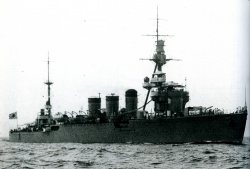
(Midori Kitakami'nin adaşı)
Adını bir nehirden alan hafif kruvazör Kitakami, toplam 40 (!!!) torpido kovanı için on adet dörtlü torpido kovanı yuvasına sahip bir "torpido kruvazörü" olarak değiştirilene kadar Kuma sınıfının oldukça sıradan bir gemisiydi. Bu nedenle, Amerikan savaş gemileri, radar ve düşük optik eksiklikleri onları bu geminin devasa torpido ateş gücü için kolay hedefler haline getireceği savaşın ilk yıllarında bir gece savaşında bu ölümcül gemiyle karşılaşmadıkları için şanslıydı. Kitakami, torpido pillerini asla tam olarak kullanmadı ve savaş sırasında bir sürü garip iş yaparak karaya çıktı ve sonunda Kaiten kamikaze mini denizaltı/insanlı torpido için bir taşıyıcı görevi gördü. 1946-47'de hurdaya çıkarılarak savaştan sağ çıktı.
IJN Maya(摩耶)

(Maya Ibuki'nin ilk isminin adaşı)
Maya, adını Kobe yakınlarındaki bir dağdan (摩耶山 Maya-san) alan dört Takao sınıfı ağır kruvazörden biriydi. Bu özel kruvazör sınıfı, bir zırhlı yerine yedek bir filo amiral gemisi görevi görecekti. Bu nedenle, Maya ve kız kardeşleri devasa, savaş gemisine benzer bir köprü yapısı ve ağır silah ve torpido silahlarıyla ayırt edildi ve Maya'nın kendisi, böyle bir savaş gerçekleşmiş olsaydı, Amerikan kruvazörlerine karşı bir savaşta zorlu bir savaşçı olurdu. 23 Ekim 1944'te Palawan Boğazları Savaşı sırasında denizaltı saldırısıyla batırıldı.
Maya adı, Akagi gibi, daha önce Maya'nın serideki Ritsuko Akagi'ye karşılıksız aşkı göz önüne alındığında ironik olan, Maya sınıfı gambotlarda kullanılıyordu. Daha da önemlisi, dağın adının doğrudan bir kişinin - Buda'nın Annesi Maya'dan (摩耶夫人) sonra verildiği, bu nedenle her ikisi de Kanji'de (摩耶 olarak) yazılmışsa Maya'nın verilen adının gemiyle aynı adı paylaşması muhtemeldir.
IJN Musashi(武蔵)
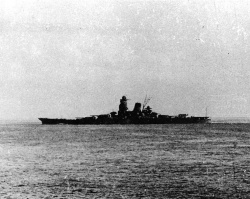
(Kanonik olmayan karakter Musashi Lee Strasberg, Girlfriend of Steel'den)
Musashi, şimdiye kadar yapılmış en büyük, en ağır silahlı ve en ağır zırhlı iki zırhlıdan biri olan güçlü Yamato'nun kardeş gemisiydi. Bu canavarların taret cephelerinde iki fit kalınlığında zırhları vardı ve dokuz ana topunun her biri 18 inç çapında ve bir aile arabası ağırlığındaki bir mermiyi kırk kilometre mesafeye ateşleyebilirdi. Ne yazık ki Japonlar için kötü motor tasarımı seçimi, bu canavarların yakıt açısından çok verimsiz olmasına yol açmıştı ve ikisi de çok uzağa gidemedi.
Amiral Isoroku Yamamoto'nun hizmete girmesinden sonra amiral gemisi olarak hizmet veren Musashi, küllerini Japonya'ya iade edecekti (Onu taşıyan uçak, özel bir ABD Ordusu Hava Kuvvetleri operasyonunda vurulduğunda yok edildi, açıklanamayan bir 'suikast'.). Yamato'ya Leyte Körfezi Savaşı için katıldı ve 24 Ekim 1944'te Amerikan uçak gemisi tabanlı uçaklar tarafından saldırıya uğradı. 17 bomba ve 20 torpido ile vuruldu (ve muhtemelen daha da fazlası, durum ne olursa olsun, bu gemi inanılmaz bir darbe aldı), büyük savaş gemisi omurgasından vuruldu ve 2399 mürettebatının binden fazlasını yanına alarak battı, geri kalanı eşlik eden muhripler tarafından kurtarıldı. Musashi, 2 Mart 2015'te Paul Allen tarafından keşfedilene kadar İkinci Dünya Savaşı'nın keşfedilmemiş en büyük batıklarından biri ve tarihin keşfedilmemiş en büyük batıklarından biri olarak kaldı.
IJN Nagara(長良)

(Sumire Nagara'nın adaşı)
1920'lerin başında, adını bir nehirden alan hafif bir kruvazördü. İkinci Dünya Savaşı'nın patlak vermesi sırasında oldukça eskimiş olan bu geminin ana şöhret iddiası, Akagi'nin terk edilmesinin ardından Midway Savaşı sırasında Amiral Nagumo'nun amiral gemisi olmasıydı. Aksi takdirde, bir muhrip filosunun öncü gemisi olarak görev yaptı. 1944'te USS Croaker denizaltısı tarafından torpidolandı ve batırıldı.
IJN Soryu(蒼龍 )
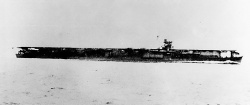
Soryu, Japon İmparatorluk Donanması'nın amaca yönelik ilk ağır uçak gemisiydi; sadece bir uçak gemisi olarak inşa edildi ve daha eski gemiler Akagi (yarı inşa edilmiş bir savaş gemisinden dönüştürülmüş) ve Kaga (yarı inşa edilmiş bir zırhlıdan dönüştürülmüş) ile öğrenilen deneyimlere dayanarak inşa edildi. Tanıtıldığı sırada, 34.5 knot hızıyla dünyanın en hızlı taşıyıcısıydı. Kaga'nın maksimum hızına tam gücünün yalnızca yüzde kırkında yetişebiliyordu ve ikiz dümenleri ona olağanüstü manevra kabiliyeti kazandırdı. Soryu'yu, yaklaşık 2000 ton daha ağır olan ve farklı bir uçuş güvertesi ve ada konfigürasyonuna sahip olan modifiye edilmiş kardeş gemisi Hiryu izledi.
Soryu, Pearl Harbor saldırısına katılan altı uçak gemisinden biriydi ve takip eden aylarda çok sayıda başka pasifik kampanyasında görev yaptı. 4 Haziran 1942'de Soryu, USS Yorktown'dan pike bombardıman uçakları tarafından saldırıya uğradı ve üç bomba isabeti aldı. İkisi üst hangar güvertesini deldi ve üçüncüsü, patlama, su şebekelerini kırma, havacılık gaz hatlarını parçalama, kazan buhar hatlarını delme ve hangar güvertelerinde depolanan silahlı ve yakıtlı uçaklar arasında zincirleme gibi bir reaksiyon başlatmadan önce alt hangar güvertesine indi. Güç kaybı, Soryu'nun gecenin ilerleyen saatlerinde muhrip torpidoları tarafından batırılmadan önce aceleyle terk edilmesine yol açtı. Soryu'nun nispeten hafif yapısı, geminin büyük ölçüde yapısal hasar görmesine neden oldu ve daha az güverte, yangın ve patlamalara yakınlığı nedeniyle makine dairesindeki ve diğer iç mekanlardaki mürettebat için daha büyük tehlike oluşturuyordu. Her iki hangar güvertesinde çıkan yangınlar nedeniyle Midway'de kaybedilen dört gemi arasında mürettebatın en yüksek oranı olan 1103 mürettebatından 711'ini kaybetti.
Tüm amaca yönelik Japon gemileri, efsanevi veya kutsal uçan yaratıkların adını almıştır. Bu durumda, Soryu kelimenin tam anlamıyla yeşil (veya mavi) ejderha anlamına gelir. Asuka'nın soyadı, taşıyıcının adının bir homofonu olmasına rağmen, bunun yerine 惣流 olarak yazıldığından, iki Kanji ayrı ayrı "her şey/hepsi" ve "akış/akı/akıntı/aktarım" anlamına gelir.
IJN Sakura and IJN Sumire (suspect)
(May be namesakes of Sakura Suzuhara and Sumire Nagara)
IJN Sakura was a Matsu-class destroyer and IJN Sumire was a Matsu Flight-II or Tachibana-class destroyer. The Matsus and Tachibanas were named after trees or flowers, with Sakura being the Japanese word for cherry blossoms (iconic in Japanese art and symbolic of the samurai) and Sumire being the Japanese violet. This entry has been listed as 'suspect' because both Sakura and Sumire are completely legitimate female names in Japan - Sakura in particular is extremely popular - and the characters may have been named after the same flowers as the warships. This placeholder entry remains pending confirmation that Sakura and Sumire were indeed named after the destroyers in question.
IJN Takao(高雄)
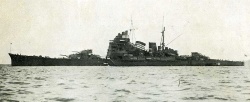
(Namesake of Koji Takao)
The heavy cruiser Takao was named after a mountain, in the same vein as Japanese heavy cruisers and battlecruisers. First in its class, it was completed in 1932 and was one of the world's most powerful cruisers at the time, with ten eight-inch guns and sixteen 24-inch torpedo tubes. As such, they were very powerful adversaries for other cruisers, during day or night. The Takao-class were distinguished by their huge bridge structures, which led to them being routinely confused for battleships. Takao was seriously damaged by two torpedoes from USS Darter in 1944. Sent to Singapore, the extent of the repairs made heading for a Japanese yard necessary. With tow impossible at that time in the war, Takao was laid up as a floating AA battery, and was subsequently damaged even further by British midget submarine XE3. It was scrapped after the war.
IJN Tama(多摩)
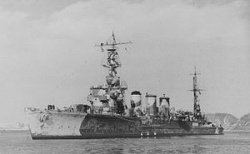
(Namesake of Hideki Tama)
Named after a river, the Tama was a Kuma-class light cruiser (the same as the Kitakami). Unlike Kitakami and Oi, it did not undergo "torpedo cruiser" conversion. Tama went about a long number of odd jobs throughout the war before being caught in the Battle of Cape Engano. Torpedoed in a boiler room during a large airstrike, the seriously damaged Tama was sent off towards Okinawa. En route, it was torpedoed and sunk with all hands by the USS Jallao.
Karakter İsimleri (Japon Deniz Öz Savunma Kuvvetleri Gemileri)
Due to the changed 'settei' (roughly, 'background') of the main characters in the Rebuild of Evangelion/Evangelion New Movie Edition, Hideaki Anno chose to rename the three female pilots after vessels of the post-war JMSDF rather than of the old Imperial Navy. At present, the three pilots have been confirmed by Anno to have been named for the post-war Ayanami-class destroyers of the Japanese Maritime Self-Defense Force. This information came from a translated interview by Hideaki Anno - previously, Asuka Langley Shikinami and Mari Illustrious Makinami were assumed to have been named after the World War Two era Shikinami and Makinami respectively, and Rei, who retains her original name in full, was assumed to have been named after the same warship as her NGE counterpart. Since the information on the post-war vessels is limited and hard to come across, the historical information on their far more interesting World War Two era namesakes has been preserved for archival purposes.
JMSDF Ayanami (DD-103)
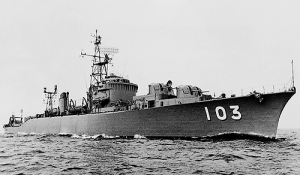
(Namesake of Rei Ayanami in Rebuild)
The Rebuild incarnation of Rei Ayanami is named after the first ship of the Ayanami class, which in turn was named after the World War Two destroyer Ayanami (listed above). These destroyers were armed with American-pattern guns and torpedo tubes and meant as anti-submarine escort vessels, all of them being named after World War II era Fubuki- and Yugumo-class destroyers.
JMSDF Shikinami (DD-106)
Placeholder space due to lack of English-language content on the JMSDF Shikinami - the information on her IJN predecessor fills this for now.
JMSDF Makinami (DD-112)
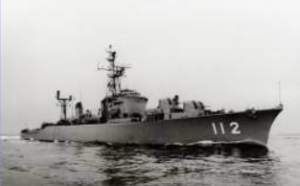
Last of the Ayanami-class destroyers.
IJN Shikinami(敷波)
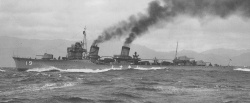
(Confirmed by Hideaki Anno that Asuka's Rebuild name, Asuka Shikinami Langley, actually comes from the post-war destroyer Shikinami, not from the Imperial Navy vessel. However, it is assumed that the Ayanami-class destroyer has the same Kanji in its name.)
Shikinami was a Type-II Fubuki class destroyer, the same model as the Ayanami. Although she was completed and commissioned before the Ayanami, she was ordered later, and construction on her began a full six months later, which is why her subclass is named "Ayanami" and not "Shikinami". Like all Fubuki-class vessels, she possessed armament and performance well ahead of other destroyers of her time.
Along with Ayanami, Isonami and Uranami, she was assigned to Destroyer Division 19 of the Japanese 2nd Fleet in 1941, and served as an escort in Admiral Yamamoto's main fleet during the Battle of Midway. She survived the Second Battle of Guadalcanal(In which Ayanami and Kirishima were lost) and allied air attacks during the Battle of the Bismarck Sea. She continued serving in escort duties until she was torpedoed and sunk by the submarine USS Growler (SS-215) on 12 September 1944.
Although Asuka's Rebuild incarnation was named after the Shikinami's Ayanami-class namesake, the Kanji used are different. The "Shiki" in Asuka Shikinami stands for "ceremony" rather than for "spreading".
IJN Makinami(巻波)
(Correction - not actually the namesake of Mari Illustrious Makinami, because Mari is named after the post-war Ayanami class destroyer Makinami. Same case as Rei Ayanami and Asuka Shikinami in Rebuild. Confirmed by Anno himself.)
Makinami was a Yugumo-class destroyer, her name meaning "overflowing waves". Makinami escorted the battleships Kongo and Haruna and heavy cruisers Maya and Myoko in the shelling of Henderson Field during the Guadalcanal campaign, running numerous transport runs to the island. She was sunk by torpedoes and gunfire during the battle of Cape St. George on 24-25 November 1943.
Karakter İsimleri (İsmi Japonca Olmayan Savaş Gemileri)
USS Langley(CV-1)
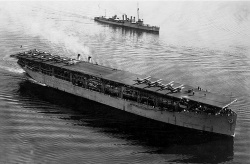
(Namesake of Asuka and her father Langley)
USS Langley was the first aircraft carrier of the United States Navy, being converted from the collier USS Jupiter, the Navy's first ship to have turboelectric propulsion (Steam-powered generators powering electric motors that turn the propellers). Named after aviation pioneer Samuel Pierpont Langley, she was later converted into a seaplane tender. On February 27, 1942, land based Japanese bombers scored five bomb hits on her. Abandoned after fires and flooding, she was scuttled by her escorts. James Lee says "No one actually saw the Langley sink" (perhaps connected with how Asuka's death or turning into LCL is not depicted at all in End of Evangelion). Coincidentally, thanks to the Japanese practice of having a nine-plane unit or chutai, USS Langley faced off the same number of attackers as Asuka did at the end of the series.
DKM Graf Zeppelin

(Namesake of Kyoko Zeppelin Soryu)
Graf Zeppelin was an aircraft carrier of the Deutsche Kriegsmarine (DKM) that was canceled when it was 95 percent complete, resources being diverted to U-Boat construction instead. The incomplete carrier fell into the hands of the Soviet Union. On 16 August 1947, it was sunk in a simulation exercise aimed at sinking a carrier, which was deemed necessary considering a possible future war with the United States. The wreck was discovered close to the Polish port of Łeba in July 2006.
HMS Illustrious
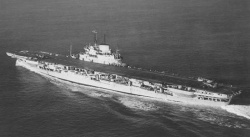
(First namesake of Mari Illustrious Makinami)
HMS Illustrious was the fourth ship of her name, an aircraft carrier of the Royal Navy. Nicknamed "Lusty", Illustrious served in the Mediterranean, where she took part in the raid on Taranto, and later suffered extensive damage from aerial attack. After a long period in the Mediterranean and the Indian Ocean, she was shifted to the British Pacific Fleet, covering the landings at Okinawa and taking three strikes from kamikaze aircraft. Seriously damaged in the last strike, she was under repair till the war ended, at which point she was reclassified as a training ship, with her speed restricted to 22 knots by wartime damage. Refitted and modernized in 1948, she served for another six years before being decommissioned and scrapped.
Fransız Savaş Gemisi Strasbourg
(Possible second namesake of non-canonical Musashi Lee Strasberg - not counting "Lee" as a ship name, which it happens to be.) The French Battleship Strasbourg was the second ship of the Dunkerque class, and built with heavier armor than her sister as a response to the Italian Littorio-class battleships. During the Second World War, Strasbourg escaped serious damage during the British attack on the anchored French fleet at Mers-el-Kebir and headed for Toulon. On 27 November 1942, the Strasbourg was scuttled with the rest of the French fleet at Toulon to prevent its seizure by the Germans. It was refloated by the Italians, seized by the German, sunk again by American air attack, refloated again (and found too badly damaged to be usable), used as a testbed for underwater explosions until condemned and scrapped in 1955.
Dış Bağlantılar
http://www.combinedfleet.com/kaigun.htm (Bu site harika.)
http://www.hazegray.org/navhist/carriers/ (Bir dizi uçak gemisine bağlantılar içeriyor.)
8. Bölüm, Evangelion 3.0 ve Evangelion 3.0 + 1.0'da Görülen Savaş Gemileri
This consists of the real-life vessels that Gainax included in Episode 08 as part of the United Nations Pacific Fleet escorting Eva-02 to Japan. It has been expanded to include the real-life vessels seen in Evangelion 3.0 as AAA Wunder's escort fleet as well as in Evangelion: 3.0 + 1.0.
USS Harry S. Truman
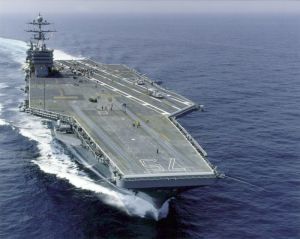
(In Evangelion, it was renamed "Over the Rainbow" and used as Pacific Fleet Flagship. Its reactors provided electrical energy for Eva-02 and the flight deck served as the stage for a short brawl between Eva-02 and Gaghiel in Episode 08.)
USS Harry S. Truman is an American Nimitz-class nuclear powered aircraft carrier, and that makes it one of the most powerful warships afloat, capable of taking ninety to a hundred combat aircraft anywhere in the world. The presence of a Nimitz-class carrier in any part of the world is, in layman's terms, big business. Truman is the eighth carrier, being named after the 33rd President of the United States, Harry S. Truman. Two more Nimitz-class carriers- the USS Ronald Reagan and the USS George H.W. Bush, have been built after the Truman, with additional modifications added along the way.
The Truman was the last carrier built before the year 2000, construction being underway at the time Evangelion aired. When it was officially commissioned (brought into service as a warship) on July 25, 1998, President Bill Clinton was the keynote speaker of the commissioning ceremony. Based in Norfolk, Virginia (As of this writing), her crew has won several awards, and the ship has taken part in numerous exercises and operations. It took part in five weeks of relief efforts in the Gulf Coast following the aftermath of Hurricane Katrina.
http://en.wikipedia.org/wiki/USS_Harry_S_Truman (Genel bilgi)
http://www.navysite.de/cvn/cvn75.html (Resmi olmayan internet sitesi)
http://www.truman.navy.mil/ (Resmi internet sitesi)
USS Abraham Lincoln
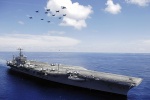
The USS Abraham Lincoln (CVN-72) is a Nimitz-class supercarrier, of the same class as the Harry S. Truman. It is seen in the support fleet for AAA Wunder in Evangelion 3.0. The ship is better known in real life for being the Aircraft Carrier that then-President George W. Bush landed on in the Persian Gulf in 2003 to give his "Mission Accomplished" speech.
USS Independence
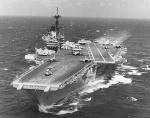
Seen in Evangelion 3.0. The USS Independence (CV-62) was an old Forrestal-class supercarrier of the United States Navy. Built in the 1950s in order to carry the increasingly large jet aircraft that were entering Naval service at the time, the four Forrestal-class supercarriers were the largest in the world at the time of their commissioning, surpassing the Second World War Japanese carrier Shinano in displacement, and greatly exceeding that vessel in both size and aircraft capacity. The nuclear-powered USS Enterprise was a derivative of the Forrestal-class design. The Independence, like all other Forrestal-class carriers, has been decommissioned and scrapped.
USS George H.W. Bush
Seen in Evangelion 3.0 and possibly in Evangelion: 3.0 + 1.0. The last of the Nimitz-class carriers and a partial transition towards the new Gerald R. Ford class of carriers, USS George H.W. Bush (CVN-77) is one of those rare ships named after a person who had been living at the time of her commissioning - others being the destroyer USS Arleigh Burke and her sister ship, USS Ronald Reagan (CVN-76). It has, among other features, a smaller, repositioned island and a different, modular construction unlike that on older Nimitz-class carriers.
USS Gerald R. Ford

Seen in Evangelion 3.0 and possibly in Evangelion: 3.0 + 1.0. The USS Gerald R. Ford (CVN-78) is the first ship of her class of aircraft carrier, being the heaviest US aircraft carrier and the heaviest warship ever built as of 2019. Unlike all the other vessels seen in Wunder's support fleet, it was under construction at the time of the show's production. It was christened in November 2013 but was not commissioned until July 2017. It incorporates a large number of improvements in design over the Nimitz-class carriers and advanced technology, such as superior electricity generation and aircraft handling, better "future proofing" for later improvements, and electromagnetic rather than steam catapults.
Heavy Missile Cruiser Kirov(Currently Admiral Ushakov)
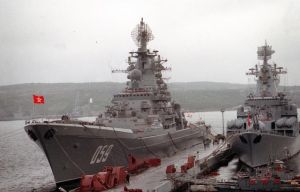
(In-series: Seen only on a display in Episode 08 with the battleships Illinois and Kentucky.)
Kirov was the first ship belonging to Russian Navy Project 1144 Orlan(Sea Eagle, the Russians named big ships after birds), classified by the Russians as a "Heavy Missile Cruiser" and known in the west as the Kirov-class battlecruiser (Note: Russians do not put their ships into "classes" named after the first vessel, as in the west). Kirov and her sister ships Frunze, Kalinin and Yuri Andropov (Renamed Admiral Ushakov, Admiral Lazarev, Admiral Nakhimov and Peter the Great respectively after the fall of the USSR) are the four largest and most powerful missile cruisers ever built, designed to attack American aircraft carriers and their escorts with their huge missiles. Classified as "heavy missile cruisers" in Russia and "Battlecruisers" in the west (Real battlecruisers are long gone, the moniker was adopted due to their size and armament), the appearance of these vessels was a factor in the reintroduction of the World War Two era Iowa class battleships in the 1980s.
Real naval ner...err, fans, please take note of the CBGN designation. NATO designations come direct from the old US Navy designations, and the USN had designated battlecruisers as "CC" (The Lexington class would have been CC-1 to CC-6 had they been completed as such) and used the "CB" designation for the "large cruisers" of the Alaska class. The Kirov CBGN designation would therefore come down to "Large cruiser, guided missile, nuclear", which meshes perfectly with the Russian designation and describes the vessels far more accurately than as "battlecruisers". Why didn't they just call them "large cruisers" or simply "cruisers"? *Shrugs*
Powered by two nuclear reactors with auxiliary steam propulsion (it sounds peculiar, but it actually makes a lot of sense), they carry twenty massive P-700 Granit anti-ship missiles, appropriately called the SS-N-19 "Shipwreck" by NATO. They have a formidable battery of anti-aircraft missiles, and an assortment of anti-submarine and close-in weapons systems, and assorted electronics systems. Weapons and electronics vary from ship to ship, with the last ship, Peter the Great, being the most advanced. At present, the surviving vessels have their condition threatened by poor maintenance and a lack of funding, although the Russian Navy does want to bring them back into their prior operational condition.
http://en.wikipedia.org/wiki/Kirov_class_battlecruiser (General information and links)
http://www.globalsecurity.org/military/world/russia/1144.htm
http://www.fas.org/man/dod-101/sys/ship/row/rus/1144.htm
Komuta Kontrol Gemisi SSV-33 Ural
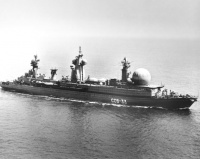
(In series: Seen - possibly as a second unit named Ural-II in Evangelion 2.0 where it serves as a Nerv command ship)
In-series article: Ural II
The SSV-33 Ural command ship or Project 1941 Titan in Soviet parlance was a large command-and-control ship with extensive electronics and communications equipment, based on the hull of the Kirov-class cruiser and with the same combined nuclear and steam powerplant. This massive vessel served in electronics intelligence gathering, missile tracking, and communications relay roles. Despite being a very powerful and capable vessel, its high operating costs and the decay of its extremely expensive equipment over the years after the fall of the Soviet Union meant that it was laid up for scrapping. Unconfirmed statements suggest that the ship was entirely scrapped by the end of 2018, but information about its exact state of existence is hard to come by.
http://www.globalsecurity.org/military/world/russia/ssv-33.htm
http://themaritimeblog.com/753/a-russian-spy-ship-turned-ghost-ship
Iowa Sınıfı Savaş Gemileri
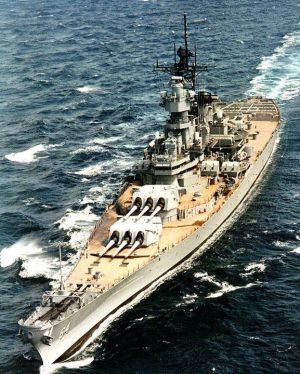
(In-series: Two ships that in real life were canceled while partially complete, Illinois (BB-65) and Kentucky (BB-66), used to destroy Gaghiel in Episode 08. One more Iowa is seen when Eva-02 makes its final landing on the carrier. Iowas seen in Evangelion 3.0 and Evangelion 3.0 + 1.0 belong in the section on "Extra Iowas" at the end of this page.)
The Iowa-class battleships were the last battleships built by the United States Navy, and the most technologically advanced battleships ever made, more powerful than all but the Japanese Yamato class. Originally planned as a class of six battleships, only four - Iowa, New Jersey, Missouri and Wisconsin - were built, with the other two, Illinois and Kentucky, scrapped while still incomplete, in 1945 and 1947 respectively. (Kentucky was to be a missile battleship if completed)[1].
The Iowas served as shore bombardment platforms like most US battleships of the period, and their high speed made them effective anti-aircraft escorts for aircraft carriers, being able to use all their secondary armament to throw up a dense curtain of fire against attacking aircraft as well as act as diversionary targets. The four ships were mothballed after World War II, brought back into action during the Korean War and then mothballed again. In 1968, New Jersey was briefly recommissioned and brought into the Vietnam War. In the 1980s, the class was recommissioned again under Ronald Reagan's 600-ship Navy initiative in the 1980's to fulfill the offshore bombardment role and provide a foil to the Kirov class "battlecruiser" with its very powerful missile armament. Part of the logic in activating them was that battleships had very thick belt armor and would be immune to sea-skimming missiles like the Exocet, which had gained notoriety during the Falklands War. (Whether large supersonic missiles like the Russian P-500 Bazalt or P-700 Granit would fare better is an unanswered question.)
They were heavily modernized and fitted out with electronic warfare systems, Phalanx CIWS, Harpoon anti-ship and Tomahawk cruise missiles. Missouri was used in Operation Desert Storm in 1991, the last wartime use of the Iowa-class. Decommissioned for good in the early 1990s, the last two Iowas were removed from the mothball fleet for good in 2006. All four are preserved in different locations in the United States as museum ships.
http://en.wikipedia.org/wiki/Iowa_class_battleship
Ağır Havacılık Kruvazörü (Uçak Gemisi) Novorossiysk
(In series: Novorossiysk seen in the Episode 08 display next to the Truman, with the designation CV-010)
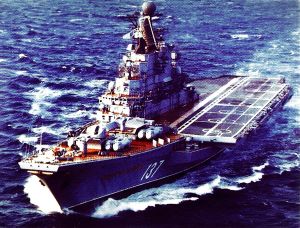
Novorossiysk was the third of the Soviet/Russian Kiev-class aircraft carriers/aviation cruisers to be built under Project 1143. By western standards, it is a hybrid between a cruiser and an aircraft carrier, carrying a mixture of helicopters and fixed-wing VTOL aircraft plus very heavy missile armament. Designated Heavy Aviation Cruisers by the USSR like the later Kuznetsov class, these ships combined eight mighty P-700(SS-N-12 Sandbox in NATO terms) anti-ship missiles along with formidable anti-aircraft missiles and six-barrel point-defense cannons. Aircraft tend to take off vertically and land on the angled flight deck.
This ship was in service with the USSR and Russia from 1982 to 1993, decommissioned in 1993, and suffered a severe engine fire in 1995, resulting in its scrapping in 1997 in Pohang, South Korea. Ironically, this makes the Novorossiysk the only ship of the Kiev class that was already on its way out of existence before the series aired and would have ceased to exist well before the events of Second Impact in 2000 - putting any of the other three surviving ships of the Kiev class would have done just fine.
https://en.wikipedia.org/wiki/Soviet_aircraft_carrier_Novorossiysk
Ağır Havacılık Kruvazörü (Uçak Gemisi) Kuznetsov
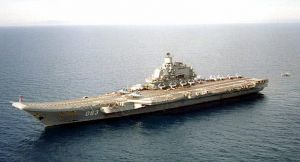
(In series: Kuznetsov seen in a few shots, and appears to have taken damage from Gaghiel. Seen again in Rebuild of Evangelion 3.0 as one of the Aircraft Carriers in Wunder's support fleet.)
Admiral Kuznetsov was built under Russian Navy Project 1143.5, as a larger and far more capable follow-on to the Project 1143, or Kiev-class. Kuznetsov is designated an Aircraft Carrier in the west and a "Heavy Aviation Cruiser" by her builders in order to transition the straits of the Dardanelles. The ship combines an air wing of Su-33 fighters and Ka-27 antisubmarine helicopters with formidable point-defense six-barrel guns and a large missile arsenal, including twelve massive P-700 (SS-N-19) antiship missiles in vertical launchers under the ski-ramp, a battery of 192 Kinzhal antiaircraft missiles and point-defense missiles from the Kashtan PD systems. Western carriers of similar size tend to carry far more aircraft and less guns or missiles, and rely on aircraft for offense rather than defense like the Kuznetsov, making this ship's Russian designation credible - no nation with an interest in filing a diplomatic complaint about their classification has done so.
Unlike American carriers that use a steam catapult system to launch aircraft, the Kuznetsov allows aircraft to take off from a ski-ramp on the bow of the ship instead. This reduces the stress on the pilot and aircraft when compared to a catapult launch, but it places a limit on the weight of the aircraft during takeoff. The Su-33 can not take off from the ski-ramp with a full load of fuel and weapons, which restricts its range and forces it to use a light loadout of weapons (mostly air-to-air missiles). Despite these limitations, aircraft on the Kuznetsov can take off and land conventionally, unlike the previous Kiev class carriers which could only carry VTOL(Vertical Takeoff and Landing) aircraft. Furthermore, the Kuznetsov's aircraft are used more as a defensive asset providing air cover for other Russian warships, unlike American aircraft carriers that are used offensively to destroy enemy aircraft, warships and ground forces.
At present, Kuznetsov is only operational carrier of the Russian Navy. In late 2012, Kuznetsov's incomplete sister vessel Varyag was completed by China as the Liaoning, China's first aircraft carrier. As of the late 2010s- early 2020s Russia has plans to modernize Kuznetsov and equip it with steam catapults like western carriers and replace the old-fashioned steam engines with gas turbines or nuclear reactors, in addition to upgraded electronics and weaponry.
http://en.wikipedia.org/wiki/Russian_aircraft_carrier_Admiral_Kuznetsov
http://www.globalsecurity.org/military/world/russia/1143_5.htm
http://www.webcom.com/~amraam/rcar.html
Slava Sınıfı CGN
(Seen in Evangelion 3.0). The "Slava" or Project 1164 Altant is a class of large guided missile cruiser, three of which were built for the Soviet Navy and all of which are in Russian service, albeit with the need for a major overhaul (also, one incomplete hull is still in Ukraine). These powerful vessels carry 16 Bazalt anti-ship missiles and 64 S-300PMU long-range surface to air missiles, in addition to defensive missiles and torpedo armament.
Hyuga Sınıfı DDH (Helikopter Muhribi)
(Seen in Evangelion 3.0) The Hyuga-class helicopter destroyer is actually a small helicopter carrier. Hyuga and her sister ship Ise are named and designated as destroyers so as to avoid violating the pacifistic principles of the Japanese constitution, which prohibits the construction of aircraft carriers, which are considered offensive units. The Hyuga-class and the even larger Izumo-class helicopter destroyers have been subject to significant political controversy due to their potential use as carriers for VTOL aircraft (USMC V-22 Osprey tilt-rotor aircraft have been operated off of these). In addition, the Hyuga and Ise were named after two World War Two battleships that were converted into battleship/carrier hybrids (one of which was the same Hyuga that Makoto Hyuga is named after), furthering the controversy surrounding these ships.
Controversies and politics aside, the Hyuga-class at present is indeed more of a defensive than an offensive unit. It is not configured to carry fixed-wing aircraft of any sort, and the position of the elevators would add further complications to flight deck operations were the operation of fixed-wing aircraft attempted. It is primarily designed for the anti-submarine role, and carries a complement of 11 helicopters in addition to defensive missile armament and Phalanx CIWS. Helicopters are stored below decks in a large internal hangar which is accessible using two elevators, fore and aft.
Oliver Hazard Perry class FFG
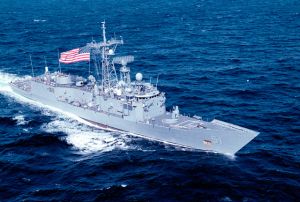
(In-series: Take the brunt of Gaghiel's attack in Episode 08. A number of them are shown burning or exploding.)
The Oliver Hazard Perry class were built in the 1970s and 80s as general-purpose escort vessels to replace a large number of aging World War II era destroyers, and take on a whole number of small roles. Built in two batches (One slightly longer than the other), these vessels are aging and now due for a major refit including a removal of obsolete offensive weaponry.
Nevertheless, the Perry class frigates have proven to be tough vessels for their size. In 1987, the frigate USS Stark was attacked, seemingly by mistake, by Iraqi Exocet anti-ship missiles and sustained severe damage, including the deaths of thirty-seven sailors, but survived. Barely a year later, USS Samuel B. Roberts was damaged by an Iranian mine, and ten severely wounded crewmen had to be taken off the ship. All Perry class frigates were decommissioned by 2015.
http://en.wikipedia.org/wiki/Oliver_Hazard_Perry_class_frigate
Hatsuyuki Sınıfı DD
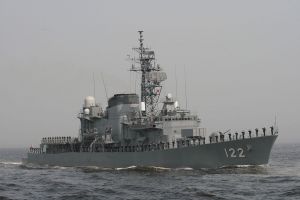
(In-series: Take the brunt of Gaghiel's attack in Episode 08. A number of them are shown burning or exploding.)
The Hatsuyuki-class DD were a gas turbine powered class of destroyer with both anti-air and anti-submarine capabilities that entered JMSDF service in the early 1980s. Several have been converted to training vessels beginning in the 2010s.
Kongo Sınıfı DDG
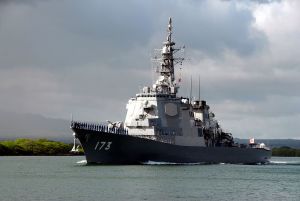
(The Japanese Kongo-class DDG is seen in both Rebuild of Evangelion 3.0 and in Episode 08. Kongo herself is identified on-screen and one ship of her class has the bridge wrecked by Eva-02 "ship-hopping")
The Japanese Kongo-class DDG is an evolution of the American Arleigh-Burke class design, but with a significantly higher bridge structure to provide improved command facilities, along with construction differences, and different armament and electronics. It is one of the few non-American warships to carry the advanced American AEGIS fire-control system to target its weaponry.
https://en.wikipedia.org/wiki/Kongō-class_destroyer
USS Ramage (Arleigh Burke Sınıfı DDG)
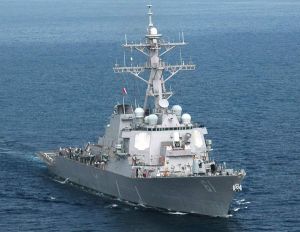
(In-series: Gun turret wrecked by Eva-02 when Asuka went "ship-hopping" in Episode 08.)
The USS Ramage is an Arleigh Burke class Destroyer of the United States Navy, commissioned in 1995 - incidentally making it one of the newest US ships in existence at the time Evangelion was in production. It, along with the other Arleigh Burke class vessels, is one of the largest and most powerful destroyers ever made, built entirely of steel(except for an aluminum mast) to reduce the damage done by antiship missile strikes. Rammage and her sisters have an air-filtration system against nuclear, biological and chemical warfare, the first US ships to use one.
http://en.wikipedia.org/wiki/USS_Ramage_%28DDG-61%29
USS Ticonderoga (Ticonderoga Sınıfı CG)
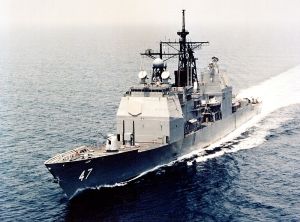
(In-series: Gun turret and bow missile launcher wrecked by Eva-02 when Asuka went "ship-hopping" in Episode 08.)
The USS Ticonderoga was one of the Ticonderoga-class guided missile cruisers, commissioned in 1980. The first ship to mount the Aegis combat system, the Ticonderoga-class were built on the modified hull and gas turbine propulsion systems of the Spruance-class destroyer, unlike the nuclear and steam-powered cruisers that had preceded them. Ticonderoga and four sister ships were retired in 2004 because of their obsolete missile systems, while newer build Ticonderogas with their far more versatile vertical launch systems continue to serve into the 21st century.
Tachikaze Sınıfı DDG
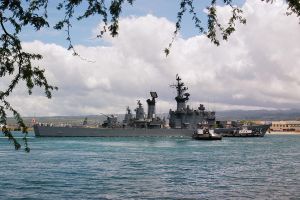
(In-series: One seen prominently while missiles are being shot at Gaghiel in Episode 08, with the bow of a second in-frame. One of the two ship models in Episode 25' appears to be that of a Tachikaze.)
A JMSDF missile destroyer that first came into service in the late 1970s. Utilized steam propulsion rather than gas turbines.
JMSDF Shirane
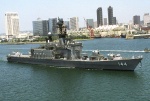
Helicopter-carrying destroyer (DDH), used primarily in the Anti-Submarine role. Seen in Evangelion 3.0 as part of the support fleet for the AAA Wunder.
Sovremenniy Sınıfı DDG

A powerful and highly capable class of Russian destroyer, used for Anti-Ship, Anti-Air and Anti-Submarine duties. Seen in Evangelion 3.0 as part of the Wunder's support fleet. These ships were originally supposed to have gas turbine propulsion but centralized restrictions on naval gas turbine propulsion resulted in them being built with somewhat smoky high-pressure steam powerplants - this doesn't seem to have hurt them at all, though.
Udaloy Sınıfı DDG
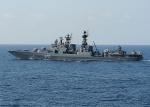
A Russian Anti-Submarine Destroyer. Seen as part of Wunder's support fleet in Evangelion 3.0. One is seen in Episode 19 where it is present for the Zeruel battle but doesn't seem to take part in it, and serves as one of the models for the vessel that Eva-02 throws during Episode 25' of the End of Evangelion. Plenty of the Udaloy and the more advanced Udaloy-II destroyers are in service with Russia at present.
Ohio Sınıfı Filo Balistik Füze Denizaltısı

Seen in Wunder's support fleet in Evangelion 3.0. American Fleet Ballistic Missile Submarine. Quiet, hard to detect, and able to let loose the apocalypse. Carries 24 Trident ballistic missiles, each with 12 Multiple Independent Reentry Vehicles (MIRVs), for a total of 288(!) nuclear warheads. The first four have been converted to Guided Missile Submarines carrying 168 Tomahawk cruise missiles each, so as to rain conventional munitions instead.
Seawolf-Sınıfı Saldırı Denizaltısı
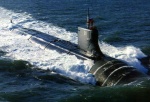
Seen in Wunder's support fleet in Evangelion 3.0. A highly advanced American attack submarine. Very quiet, very large, and equipped with a very expensive and powerful sonar suite. Only three were built due to sheer cost and the collapse of the Soviet Union eliminated the threat of high-speed, deep-diving Russian submarines that the Seawolf was meant to go up against. Followed by the (marginally) cheaper Virginia class attack submarine.
Animedeki Diğer Savaş Gemileri
This includes naval vessels that are present in the show under odd circumstances, such as fictional equivalents of real-life vessels.
DDG-099 Farragut
(In-series: Gendo transmits from this vessel, off screen, at the end of Episode 12. Unlike the other warships seen in Neon Genesis Evangelion, it didn't exist at the time the show was made.)
Farragut is an Arleigh Burke-class destroyer of the US Navy, the 49th ship of the Arleigh Burke class. It was laid down on January 9, 2004 and christened on July 23, 2005, and commissioned on June 10, 2006. Since this vessel didn't come into existence until a good decade after the show aired, the DDG-099 that Gendo transmits from could be interpreted as a fictitious version of the Farragut.
http://en.wikipedia.org/wiki/USS_Farragut_%28DDG-99%29
Ekstra Iowalar
Five unidentified Iowa-class battleships, all in pre-refit condition, are seen again in Evangelion 3.0 as part of the support fleet for the AAA Wunder. Evangelion: 3.0 + 1.0 suggests that naval history in the movies diverges even further from that in real life since it features eight Iowa class battleships at Paris, and trying to identify individual vessels in 3.0 + 1.0 is impossible because some of the battleships are bizarrely in 1940s configurations with seaplane catapults and a full set of guns, others in their 1980s reconstructions with Tomahawk missile launchers.
In reality, there were only ever meant to be six Iowa-class battleships built before construction was meant to shift to the planned Montana-class battleships. Four of them -Iowa, New Jersey, Missouri and Wisconsin- were completed, served in World War II and were heavily upgraded in the 1980s(the upgraded Iowas appear to have been accurately depicted) plus two, Illinois and Kentucky that had their construction delayed, were left incomplete and scrapped in the late 1940s after any plans for converting them fell through. Additional Iowas were never built and construction on the planned Montana-class battleships never even began due to the US need for carriers during the Second World War and the lack of any further need for new battleships well before the war ended. This makes the extra Iowas seen in 3.0 and 3.0 + 1.0 entirely fictitious and without any sort of basis in reality, unlike the Illinois and Kentucky from Episode 08 which physically existed even if they were scrapped before they could see service.
Nerv Savaş Gemileri
Nerv keeps a destroyer stationed in the lake in the Geofront, and what looks like a small frigate or patrol vessel in the lake of LCL in Terminal Dogma. It is unclear whether these are meant to be real-life warships. Neither of them are shown taking part in Angel battles or other events for which they are actually in physical proximity, and it is even less clear how Nerv managed to bring them so far underground in the first place.
In Episode 19, the destroyer present in the Geofront lake is clearly an Udaloy, and in Episode 25', Asuka in Eva-02 lifts and throws a destroyer with clear "NERV" markings out of the Geofront lake and onto the attacking JSSDF forces. There are two ship models used in Episode 25' - the initial model seen in the wide shot when Eva-02 generates the cross-shaped explosion appears to be modeled off a Japanese Tachikaze-class destroyer. But when the same ship is lifted and thrown it clearly appears to be modeled off of a Russian Udaloy-class destroyer as in Episode 19 (a larger vessel with a visibly different profile). The Udaloy-class is a major surface combatant with a displacement of approximately 7000 tons and the Tachikaze-class destroyer, although smaller, displaces nearly 4000 tons, so whatever the warship is meant to be, it raises questions about how Nerv brought something so massive so deep underground, and for what purpose.
